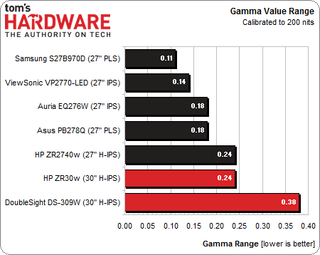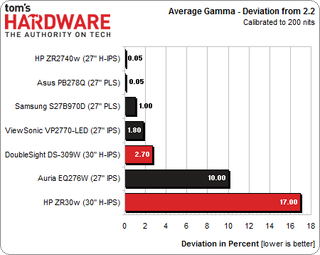HP ZR30w Versus DoubleSight DS-309W, 30-Inch Monitors, Tested
With a steady stream of 27-inch QHD monitors coming through our lab, we thought we’d take a quick break and test two even bigger screens, the 30-inch, 16:10 aspect ratio HP ZR30w and DoubleSight DS-309W. How do these $1000+ stunners compare?
Results: Gamma And ANSI Contrast Ratio
Gamma is the measurement of luminance levels at every step in the brightness range from 0 to 100 percent. This is important because poor gamma can either crush detail at various points or wash it out, making the entire picture appear flat and dull. Correct gamma produces a more three-dimensional image, with greater depth and pop. Meanwhile, incorrect gamma can negatively affect image quality, even in monitors with high contrast ratios.
In the gamma charts below, the yellow line represents 2.2, which is the most widely accepted standard for television, film, and computer graphics production. The closer the white measurement trace comes to 2.2, the better.

The HP’s gamma rides right around the 2.0 mark, which is a bit lower than the 2.2 standard. This results in an image with slightly less perceived contrast, especially in darker content where the gamma value is below 2.0. The tracking is reasonably flat, which is a plus. If HP added a gamma control, this issue could be fixed easily.
The DoubleSight also lacks a gamma selector. Let’s see how it turned out.

The DS-309W seems to be the opposite of the HP. The gamma is fine at the lowest signal levels and gradually rises to over 2.5 at the 90 percent point. This is a small error, and one that should be nearly invisible to the naked eye. Nevertheless, the DoubleSight’s tracking is not quite as good as the HP screen.
Here’s how our 30-inch panels compare to the 27-inch competition.

With a range of values spanning as high as 0.38, both monitors finish at the back in this metric. While their gamma tracking is fair, it isn’t quite as good as the other five screens.
Stay on the Cutting Edge
Join the experts who read Tom's Hardware for the inside track on enthusiast PC tech news — and have for over 25 years. We'll send breaking news and in-depth reviews of CPUs, GPUs, AI, maker hardware and more straight to your inbox.
By expressing the gamma error in percentage of deviation, rather than showing the absolute value, it’s a little easier to compare the performance of all the monitors.

With a low average value of 1.83, the HP ZR30w finishes last in gamma performance. The DoubleSight fares better because it sticks closer to the correct 2.2 standard. Its overall error is extremely small compared to the Auria and the HP.
ANSI Contrast Ratio
Another important measure of contrast is ANSI. To perform this test, a checkerboard pattern of sixteen zero and 100 percent squares are measured. This is somewhat more real-world than on/off measurements because it tests a display’s ability to simultaneously maintain both low black and full white levels, while factoring in screen uniformity. The average of the eight full-white measurements is divided by the average of the eight full-black measurements to arrive at the ANSI result.

The HP’s ANSI number comes in a little lower than its on/off measurement. It is still quite high, however, at over 750 to 1. Only the 27-inch HP and the Asus QHD monitor from our last review do better in this test. The DoubleSight’s ANSI contrast is only a bit below its on/off number. This demonstrates consistent performance regardless of image content. In use, both panels look very good whether watching video, playing games, or working with productivity applications.
Current page: Results: Gamma And ANSI Contrast Ratio
Prev Page Results: Calibrated Brightness And Contrast Next Page Results: Grayscale Tracking
Christian Eberle is a Contributing Editor for Tom's Hardware US. He's a veteran reviewer of A/V equipment, specializing in monitors. Christian began his obsession with tech when he built his first PC in 1991, a 286 running DOS 3.0 at a blazing 12MHz. In 2006, he undertook training from the Imaging Science Foundation in video calibration and testing and thus started a passion for precise imaging that persists to this day. He is also a professional musician with a degree from the New England Conservatory as a classical bassoonist which he used to good effect as a performer with the West Point Army Band from 1987 to 2013. He enjoys watching movies and listening to high-end audio in his custom-built home theater and can be seen riding trails near his home on a race-ready ICE VTX recumbent trike. Christian enjoys the endless summer in Florida where he lives with his wife and Chihuahua and plays with orchestras around the state.
-
vmem "And for those who demand a density above 100 pixels per inch and a tall 16:10 aspect ratio, they represent the top of the heap...for now"Reply
Isn't the ASUS PQ321 already out along with a few other 4K monitors? granted price is a whole other story -
Marcus52 The lack of an OSD makes the ZR30w a much better gaming monitor, as the OSD causes higher lag. Personally I have no problem doing without one.Reply
You seriously can't see the pixels? I can see them on a 27" 2560x1440, which has smaller pixels. The .25mm range is adequate to me, but really I'd prefer something smaller than the .233mm on the 2560x1440. -
x2ruff4u You guys should wait to get any IPS screen. 60HZ is all they come in & tbh 60HZ in terms of technology is old. I would wait to get a 120HZ IPS monitor because it REALLY makes a difference. Sure you can OC your monitor, but most only go up to 90HZ and that can put a toll on it and eventually fry it. Your best bet is to get a 120hz-240hz TV and if your worried about MS don't be. Compared a low MS to a higher HZ there is very little difference in tech terms (read up about it) This year or beginning of next year WE should be getting some nice monitors you can be proud you spent your money. Hell ASUS already has a 4K monitor and I bet money on 4K monitors by mid-end next year.Reply -
Onus Troll post(s) deleted.Reply
When considering something like this for games, don't forget the cost of the video card(s) needed to drive it. A HD7750 may be "sufferable" even up to 1920x1080, but I'm not sure even a HD7770 or GTX650Ti could play newer games on better than "low" settings on one of these.
-
kungpaoshizi How the heck did you get those numbers via the input pcb for input lag?Reply
I have a ZR30W myself, and I would NEVER trade it unless what I'm upgrading to has more than a 2560x1600 resolution.
I've played on all sorts of monitors, and resolution trumps all other specs, unless you're dealing with 30fps or something...
I really wish I would have spent 1200$ on it long ago. Battlefield 3 and other highly graphical games are comparable to nothing else in the world. -
kungpaoshizi Oh btw, I run BF3 high/ultra settings with a GTX 570 oc'd, and it's peachy enough I don't tell my g/f I'm taking my other 570 out of the machine she's using to hook up SLI again...Reply
The 60hz is not "old tech", it's more than sufficient to run games smoothly if vertical sync is on (even still when it's off). 60 fps is fine, television (pre hd) was 28hz. Anything above 60fps you really don't notice too much.
Oh, and for those looking for 4k tv's to use (I'm way ahead of ya) they only have 30hz refresh rates over the HDMI 1.2 port. We're going to have to wait for the tv's to add another port, wait for the upgrade to HDMI 2.0, or wait for some other solution. -
hero1 I can safely say that I will sit tight and wait for the 4K monitors to hit the market at a reasonable price and grab one as long as they come in at 60Hz or 120Hz and not 30Hz.Reply -
RedJaron It's a shame manufacturers treat 16:10 ratio as a rarity. A decent 1080p is often a little cheaper than a smaller 1680x1050 display and half as much as a slightly larger 1920x1200. Personally I can't stand a 16:9 for a computer. It's fine for TVs and watching media, but to work on I have to have that extra height.Reply -
hero1 Reply11058091 said:It's a shame manufacturers treat 16:10 ratio as a rarity. A decent 1080p is often a little cheaper than a smaller 1680x1050 display and half as much as a slightly larger 1920x1200. Personally I can't stand a 16:9 for a computer. It's fine for TVs and watching media, but to work on I have to have that extra height.
We aren't going to see many 16:10 in the future. the 4K stuff is going to be 16:9 unless someone makes the move to stick with 16:10. However, the difference when it comes to 16:9 with a 2560x1440 and 16:10 2560x1600 is very minimal unless you really really need that extra height!
Most Popular

